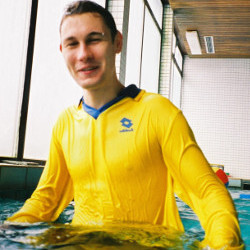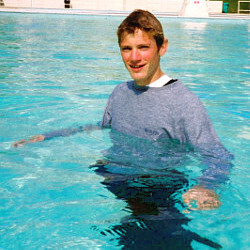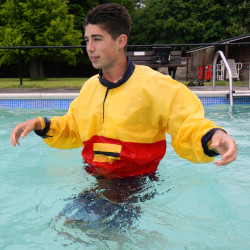Aquatic Boot Camp
Aquatic Boot Camp is like Crossfit but very wet. This is NOT water aerobics, and your only easy day was yesterday!
Do you want to take part in the new fitness trend that is sweeping the world? Have you ever wondered if you're pushing yourself hard enough? You're not!
Aquatic Boot Camp (ABC) is much different from other boot camps, because it consists of land and water exercises, hence it's called amphibious. It combines rigorous cross-training of swimming, water aerobics, and modified plyometrics with traditional strength and cardio-vascular training. Memorize these training elements well. There will be no time later.
This training does more than just get you in shape and consists of a variety of lifeguard type functional swimming exercises that combine endurance and resistance training for total body aqua toning. It helps develop your swimming ability, physical fitness, and confidence in yourself.
Who is Aqua Boot Camp for?
Aquatic Boot Camp is very suitable for the fit athlete,
but also for those who want to build fitness and muscle strength.
It has a much higher intensity than Aquajogging and Aquarobics
and some fitness condition is therefore desirable.
These challenging sessions are especially for all those go-getters
who want to give that little bit extra and push their limits,
like fitness enthusiasts, adventurers, lifeguards, tri-athletes, beach bums, surfers,
and anyone who likes to be challenged.
Aquatic Boot Camp is Tough
For optimum effect Aquatic Boot Camp training you'll be fully clothed in the water throughout the entire course. Swimming trainers and lifeguards adapt this aquatic or amphibian training for their teams, whilst others have toned it down to the level of mere aquarobics with clothes on. If you come across classes that don't use clothing, you're looking at basic aquarobics of some kind, not an aquatic boot camp.
You should be confident in the water and able to swim fully clothed for 50 meters without stopping,
dive down to a depth of 2 meters, and tread water for 3 minutes.
If you're not yet this fit, go to a local swimming pool and swim in a jogging suit or tracksuit until you reach this level.
Make sure they fit well and you can confidently swim in them.
Nothing is more annoying than badly fitting swim clothes.
Get Going
Begin by finding a training venue. Well managed pools typically have steps, ropes, rubber bricks, and other useful equipment. You need a pool that allows for clothing to be worn in the water.
Once you found a vanue, identify and write down the specific workouts you’re going to accomplish. Select the places at your chosen location where you will perform any poolside exercises. Pick a lane or pool for the water training.
Be sure to take along essentials that will keep you in the pool from start to finish. These includes a water bottle, snack(s), towel, a pile of clothes that can get wet, and a fitness watch to time your exercises and keep track of your heart rate.
Qualified Lifeguards
Lifeguards should be present at all times during your lifesaving or survival swim training.
They should have a current Lifeguard Training certificate (Red Cross or equivalent)
and must be certified in first aid and CPR (cardiopulmonary resuscitation).
If you have more than one lifeguard, place one on poolside,
the others go into the pool near your class.
Rotate lifeguards every 20 minutes so they all get a chance for a swim.
Fresh Clothes
Change into fresh swimming clothes on-site. They must be clean and colour-fast and should consist of "man-made" fibres that don't leak dye. The material has to be in good condition, not fraying or shedding fluff which could block the pool filters.
Go through the showers in these clothes before entering the pool. Make sure you rinse and soak them well. Dry spots show the pool staff that you haven't taken a proper shower. Besides, it's great fun.
Pool Safety
Pick up right away any clothes you may drop to the pool bottom, as they may confuse the lifeguards.
Large items of clothing floating in the pool can be mistaken as casualties and are also a hindrance for swimmers.
Move any clothes you currently don't need for your training to a safe place on the pool side,
out the the way of other pool users.
Clothing Layers Instead of Gym Weights
You can adapt a variety of fitness exercises for use in the pool, using the weight and drag resistance of clothing layers in the water instead of gym weights. This spreads the load more evenly over your body.
Layers in water are like weight lifting on land. The more you wear, the harder your workout gets, and the better your results, but without increased risk of injury. You can go up or down a notch by adding or removing a layer.
A full body swimsuit is very easy to swim in and reduces muscle vibration which leads to a better workout. When you add a thin unlined nylon anorak it increases the resistance of your moves in the water and the load on your muscles for more strength building. Thin anoraks add drag for resistance swimming but don't soak up much water.
Adjust your kit to your required fitness level. As you get stronger add a sweatshirt or hoodie under the anorak, and replace swim suit with long running tights or jogging pants. They will soak up more water which adds weight to your workout, making this training much more demanding.
Below are a few comfortable clothing ideas you may want to try in your local pool before you go to an aquatic bootcamp:

Start with a single clothing layer, like running tights and long shirt.

As bootcamp progresses you add more layers to make it harder.

Anoraks and rain pants make fast drying swim clothes.
Reader Comments
Aquatic Boot Camp is Awesome!
I hate the gym, and I get bored with workouts easily. Here every day has a different form of water torture, but I feel amazing when I walk out (if I can even walk out!). I've been doing the program for 10 weeks now and have not only lost 4kg in weight, but my endurance and energy throughout the course has gone up a lot. ~ Torin
Not Grandma's Water Aerobics
This is tough and definitely not your grandma's water aerobics.
This training will kick you hard all the way across the pool and back.
All the exercises have to be done fully clothed,
both in the water and then wet and heavy on the poolside.
Incredible.
Never tell the instructor it was too easy.
You'll regret it next class.
~ Martin
Swim Club
Our swim club started aquatic bootcamp sessions and it's tough because of the heavy wet clothes. The combination of poolside moves, swimming, and random exercises in the pool was exactly what I needed to get into a habit. I always feel energized afterwards. ~ Sandra
Fast Paced Workout
The workouts are fast paced, challenging,
and incorporate a good mix of water work and poolside exercises in heavy wet clothes (no boring lap swimming).
If you enjoy being in the water but are not particularly motivated to pump irons at the gym, you need to try this!
Just when you think you have no more to give, you get back in the water and swim more sprints.
The wet clothes are so heavy and show no mercy.
~ Marcelo
Better Than Boring Pool Laps
As a keen swimmer I always looked for something more challenging than endless boring laps in the pool. When a few friends of mine stumbled across this website, we decided to give this training a go. To save money we went to the local army surplus shop and bought simple field uniforms with rain gear and ponchos. That was much cheaper than swim shorts and tracksuits.
We now swim every week for two hours in a local pool where we can do these exercises.
Layered clothing helps to vary the exercise level.
Between lengths we climb and jump a lot, and do the poolside drills.
It's a lot more fun than boring swimming clubs.
~ Eddie, Vancouver, Canada
UV Sun Sensitive Skin
Thank you for a programme I can use and get fit. I have to swim fully clothed with the hood up because of my light sensitive skin and high sunburn risk, so your training is just right for me. The aquatic bootcamp course is a powerful exercise and much more fun than a dry gym.
Up to four times a week I jump into the local outdoor pool and do cross training in hooded sports kit or casual clothes. At the beginning I do the warm-up exercises, then I do several laps of resistance swimming. Between the laps I do the strength training.
Then I go running in the wet clothes which makes it much harder. By the time I get home my clothes are almost dry and I enjoy a shower to rinse the chlorine and sweat out of my kit. Great fun. ~ Andrew, Brisbane, Australia
Lifeguard Team
Our team does this workout every week.
My favourite part is how much they mix things up so you don't get bored!
Each class typically consists some swimming laps for cardio, dry land abs/stretching,
pull/kick drills for more cardio, hoodie swimming for strength, on the wall drills for added abs/strength, and more.
We wear different clothes each time.
The heavy wet clothes make it really hard.
This is so much more than doing laps on your own and the farthest thing from water aerobics.
~ Corey